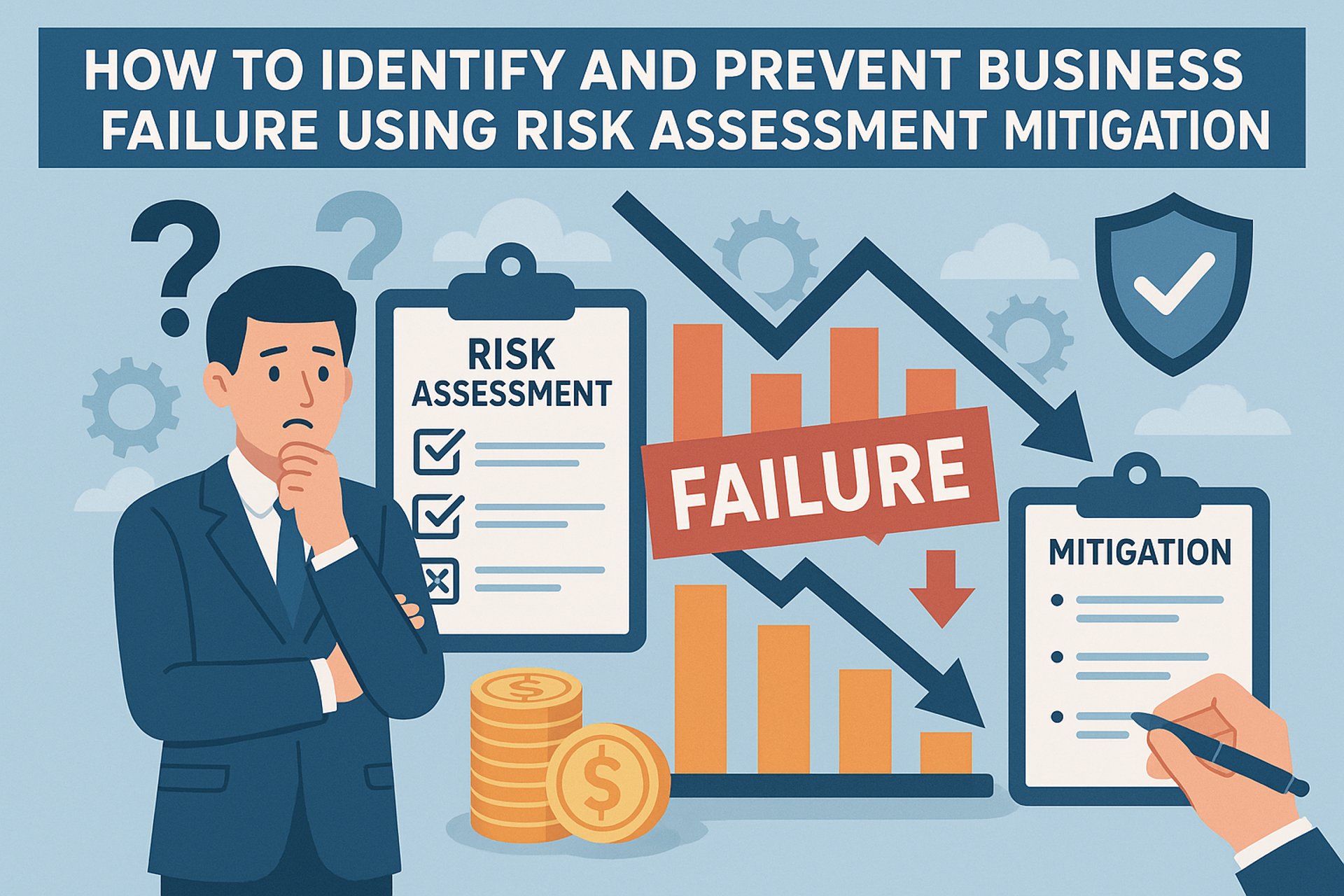Identify & Prevent Business Failure with Risk Mitigation
SMEs excel with risk assessment and mitigation through tailored content, in-depth case studies, and step-by-step actions to build resilience and long-term growth.
8/11/20255 min read

Introduction to Risk Assessment and Mitigation
Small and mid-market enterprises (SMEs) operating in dynamic competitive markets require risk assessment together with mitigation strategies to stay successful. The unique combination of restricted resources and minimal staff and market volatility demands that SMEs understand their potential threats to survive.
Organizations need to understand risks for reasons that extend beyond danger avoidance because it creates the base for long-term expansion. Businesses that conduct risk assessment develop strategic advantages by detecting impending threats before they create disruptions. Leaders who use structured analysis methods can identify operational and financial risks along with reputational threats which enables them to develop necessary plans.
Business risks exist in four primary categories which include operational and financial risks together with compliance and reputational risks.
Operational risks develop from internal system breakdowns and process deficiencies as well as human mistakes.
The financial sector faces risks that stem from market volatility as well as credit challenges and unstable cash flow.
Non-compliance with laws and regulations results in both financial penalties and damage to organizational reputation.
Reputational risks develop when public opinions become unfavorable which damages both customer faith and market worth.
Risk mitigation strategies aim to lower both the chances of occurrence and the intensity of these threats. Organizations should establish solid policies and adopt efficient procedures and invest in technology while providing staff training. Proper mitigation strategies protect innovation by developing an essential security base which enables business expansion.
Organizations that include risk awareness in their strategic planning processes achieve better confidence and faster response times while protecting their future sustainability.
Understanding Preventable Risks
Most potential risks can be managed in advance of causing significant damage. The main preventable risks consist of strategic, financial, operational, commercial, supply chain, compliance and people/process risks.
The strategic risks directly target a company's future objectives. Market demand changes and disruptive technologies and new competitors typically cause such threats. Continuous market analysis serves to prevent the quick deterioration of a company's value proposition.
Financial risks stem from elements that diminish asset worth or lead to liquidity problems. Financial risks can be identified through market volatility alongside debt mismanagement and inadequate internal control systems. Financial oversight needs to stay disciplined to stop cash flow crises from occurring.
The emergence of operational risks happens when daily business systems and management processes show inefficiencies or age out of date or receive inadequate oversight. The risks become more intense when employees do not receive proper training or do not have suitable tools. The continuous review and update process ensures operations maintain proper functionality.
Commercial risks develop when organizations incorrectly understand market preferences or cannot adapt to market shifts. Poor forecasting leads to resource waste and unsold inventory.
The supply chain faces risks when vendors experience breakdowns or global events disrupt operations or transport methods become delayed. Companies should establish reliable backup plans and maintain diverse supplier networks to avoid costly bottlenecks.
The violation of regulatory requirements leads to financial and legal penalties because of compliance risks.
The operational disruption caused by people and process risks includes both high employee turnover and low morale and skill deficits.
The targeted strategies needed for supply chain stability do not apply to regulatory compliance management. A single standard solution proves expensive because it does not work for every situation.
Risk Assessment in Business Turnaround Strategies
When a business shows signs of severe decline risk assessment takes its position as the fundamental element for developing turnaround strategies. The process involves more than survival because it requires business transformation for success.
The initial stage of assessment requires businesses to identify threats and weaknesses across their entire operations including financial performance and customer retention and supply chain stability. The examination requires an extensive exploration of every failure possibility throughout all operational areas.
The assessment process should also reveal possibilities for enhancement. The analysis of customer data can expose vacant market segments together with potential new product ranges. Risk management transforms into strategic development through proactive methods instead of being restricted to defensive measures.
Turnaround environments require both rapid action and exact execution. The organizations that achieve the fastest recovery times possess ongoing condition monitoring along with fast adaptation to new information and proactive prevention of small problems from escalating into major crises. These organizations stay agile and resilient because they incorporate risk monitoring into their regular business operations.
Step-by-Step Guide to Identifying Risks
Risk identification requires more than basic problem listing because it involves collecting diverse viewpoints and analyzing data to create organized information for effective leadership action.
The first step requires stakeholders to participate in a brainstorming session.
The process requires managers together with front-line employees and other essential contributors to form a team. Each group sees different parts of the business and different risk exposures. Encourage open, judgment-free discussions so all ideas surface.
Step 2 – Conduct a SWOT analysis
Internal strengths and weaknesses need evaluation together with external opportunities and threats during this assessment. A structured approach helps organizations prevent missing important yet important vulnerabilities.
Step 3 – Build a risk register
The identified risks should be documented through a risk register that includes their origin as well as their possible effects and first indicators of potential issues. This documentation serves as the fundamental element for your ongoing monitoring activities.
Step 4 – Use risk heat maps for prioritization
Each identified risk needs to be represented on a visual scale based on its predicted impact level and potential occurrence chance. Leaders can use this visual system to determine which threats require their most important resource allocation based on operational disruption potential and major loss risk.
The system provides complete risk identification alongside organizational structure and executable outcomes.
Mitigation Strategies: Preventative Measures That Work
Risk mitigation aims to establish control systems which help organizations prepare for future challenges. Different threats require various mitigation strategies yet several effective methods work across different industries.
Companies can mitigate financial risks by adopting detailed budgeting processes and precise forecasting methods and specific performance indicator systems. Organizations should keep cash reserves available for handling unexpected expenses along with market downturns.
Standard procedures together with continuous staff training represent operational risk mitigation strategies. Your organization should develop clear operational manuals which will help maintain standardized correct task execution.
The mitigation of compliance risks requires scheduled audits with automated tracking tools and updated checklists for real-time compliance monitoring.
The system requires businesses to establish KPIs along with performance thresholds which will initiate immediate response when metrics decline.
The process of effective mitigation involves proactive measures instead of reacting to situations after they occur. Risk management involves continuous efforts to detect weaknesses before implementing solution tests and method improvements that will maintain risks at appropriate levels.
Case Studies: Success Stories of Turnaround
During the pandemic outbreak the mid-sized manufacturing company reviewed its supply chain and worker safety systems after market demand sharply declined. Scenario planning helped the organization develop multiple contingency plans that allowed it to shift production toward manufacturing PPE products. The company achieved operational stability through these measures and successfully expanded its market presence.
The retailer experienced stock buildup and sales reduction due to changing consumer purchasing patterns. The company conducted an extensive risk evaluation before using analytics to track customer behavior while reshaping its inventory system according to market demands. The company achieved stability and gained new customers through its e-commerce expansion.
The successful examples demonstrate how rapid data-based risk evaluations combined with swift strategic choices transform organizational threats into beneficial opportunities.
Conclusion and Call to Action
The unpredictable market demands both risk assessment and mitigation because these elements represent basic requirements for business survival and development. Organizations that perform early actions and create detailed plans while adapting swiftly will navigate through disruptions to establish themselves as leaders in future markets.
Key takeaways:
The first step is to recognize every type of risk that includes financial risks alongside operational risks and strategic risks and reputational risks.
Companies need to execute regular assessments as a method to reveal their vulnerabilities.
Organizations should establish detailed plans for risk mitigation with defined responsibilities and specific implementation periods.
The organization needs to create an environment that makes risk awareness a routine element in all decision-making processes.
Action checklist:
1. Perform a full risk assessment.
2. Involve your team in risk discussions.
3. Develop tailored mitigation strategies.
4. Review and update plans quarterly or after major changes.
5. Use a 30-60-90 day framework for staged implementation.
FAQ
• How often should assessments be done? Quarterly or whenever major changes occur.
A risk management plan must contain all identified risks together with their mitigation steps and responsible parties and implementation timelines.
The implementation of proactive measures leads to organizational resilience. The organizations that prepare their strategies now will guide the direction of business operations in the future.
Consulting
Empowering businesses through strategic consulting solutions.
Growth
Success
+966553997996
© 2025. All rights reserved.
